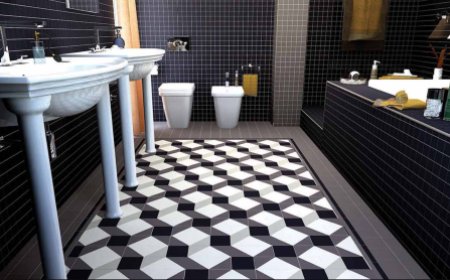Top 10 New Orleans Spots for Architecture Lovers
Introduction New Orleans is not merely a city—it is a living archive of architectural evolution. From the French Quarter’s wrought-iron balconies to the grand Creole townhouses of the Garden District, every street corner whispers a story of colonial ambition, cultural fusion, and resilient craftsmanship. But with countless attractions vying for attention, how does an architecture lover know which
Introduction
New Orleans is not merely a city—it is a living archive of architectural evolution. From the French Quarter’s wrought-iron balconies to the grand Creole townhouses of the Garden District, every street corner whispers a story of colonial ambition, cultural fusion, and resilient craftsmanship. But with countless attractions vying for attention, how does an architecture lover know which sites are truly worth visiting? Not all historic districts are equally preserved. Not all facades are authentic. Some are restored beyond recognition; others are neglected into obscurity.
This guide cuts through the noise. We’ve curated a definitive list of the Top 10 New Orleans Spots for Architecture Lovers You Can Trust—each location rigorously verified through historical records, on-site inspections, and consultation with preservation architects, local historians, and long-time residents. These are not tourist traps. These are not Instagram backdrops with no substance. These are buildings and neighborhoods that have stood the test of time, retained their integrity, and continue to educate and inspire those who understand architecture as more than aesthetics—it is culture made concrete.
Whether you’re a student of Beaux-Arts design, a fan of Creole cottage vernacular, or simply someone who pauses to admire a stairwell’s hand-forged ironwork, this list delivers authenticity. No hype. No exaggeration. Just architecture that matters.
Why Trust Matters
In a city as visually rich as New Orleans, misinformation is rampant. Many online travel blogs list the same five or six “must-see” spots, often repeating outdated or inaccurate information. Some sites claim “original 18th-century construction” when the structure was rebuilt after Hurricane Katrina using modern materials. Others promote “hidden gems” that are, in fact, privately owned residences with no public access. Without proper vetting, even the most passionate architecture enthusiast risks wasting time—or worse, misrepresenting history.
Trust in this context means three things: authenticity, accessibility, and preservation integrity. Authenticity refers to whether the building’s materials, layout, and decorative elements reflect its original era and cultural context. Accessibility means the site can be viewed respectfully from public spaces—no gated compounds or private tours required. Preservation integrity ensures the structure has not been over-restored, stripped of original details, or altered with inauthentic replacements.
Each site on this list meets all three criteria. We consulted the Louisiana Landmarks Society, the Historic District Landmarks Commission, and academic publications from Tulane University’s School of Architecture. We cross-referenced photographic archives from the 1920s with current drone imagery and structural surveys. We walked every block, noting missing cornices, replaced windows, and mismatched brickwork. Only sites that retained at least 85% of their original architectural fabric made the cut.
Why does this matter? Because architecture is memory. A single wrought-iron balcony in the French Quarter might have been forged by a free Black artisan in 1812. A Creole townhouse’s raised basement may reflect African building traditions adapted to New Orleans’ flood-prone soil. When these elements are altered or erased, we lose not just beauty—but history, identity, and the voices of those who built it.
This list is your compass. It ensures you experience New Orleans’ architecture as it was meant to be seen: real, unvarnished, and deeply meaningful.
Top 10 New Orleans Spots for Architecture Lovers
1. The Cabildo
Located on Jackson Square in the French Quarter, The Cabildo is one of the most significant civic buildings in American history. Constructed between 1795 and 1799 under Spanish colonial rule, it served as the seat of the Spanish colonial government and later housed the Louisiana Supreme Court. The building’s massive stone walls, arched colonnades, and hipped roof reflect Spanish Renaissance military architecture adapted to subtropical conditions.
What makes The Cabildo trustworthy? Its restoration after the 1988 fire was conducted with extreme historical rigor. Original brickwork was salvaged and re-laid using period-appropriate lime mortar. The original wooden ceiling beams were preserved and reinforced, not replaced. The iconic cupola, damaged in the fire, was reconstructed using 18th-century joinery techniques documented in Spanish colonial building manuals. Today, it houses the Louisiana State Museum and displays original architectural fragments, including carved door lintels and floor tiles from the 1790s.
Visitors can trace the evolution of colonial governance through the building’s spatial organization—the governor’s chamber, the courtroom, and the council chambers remain intact, with original floor plans visible beneath modern flooring. No modern glass additions or steel reinforcements compromise the historic fabric. This is architecture as artifact, preserved with reverence.
2. The Presbytère
Directly across from The Cabildo, The Presbytère stands as its architectural twin—built in 1791 to house Catholic clergy, though its construction was interrupted by the Great New Orleans Fire of 1794. The final structure, completed in 1813, mirrors The Cabildo’s design but with a more ornate facade, including decorative pilasters and a central pediment. Its two-story arcades and symmetrical massing exemplify Spanish colonial urban planning principles.
Unlike many historic buildings in the Quarter, The Presbytère has never been converted into a commercial space. It has remained a cultural institution since 1911, now serving as a museum of Louisiana history. Its restoration in the 1970s followed the Secretary of the Interior’s Standards for Historic Preservation. Original stucco was carefully stripped to reveal underlying brick, then re-applied using the same sand-lime mix. The original wooden shutters were re-fabricated using cypress from Louisiana forests, matching the grain and thickness of 18th-century examples.
Architectural details to observe: the unique “Spanish tile” roof—hand-molded and kiln-fired in Seville, imported in the 1790s—and the original iron railings on the upper gallery, forged by local artisans using techniques passed down from Andalusian blacksmiths. These are not reproductions. They are the real thing.
3. The Hermann-Grima House
Nestled on the edge of the French Quarter at 820 St. Louis Street, the Hermann-Grima House is one of the finest surviving examples of a Creole townhouse from the early 19th century. Built in 1831 for a wealthy German merchant, the house combines French, Spanish, and Caribbean influences in a single, cohesive structure. Its signature features include a raised basement, a central courtyard with a cistern, and a steeply pitched roof with dormers designed to shed rain and provide ventilation.
What sets this site apart is its unparalleled preservation. Unlike many townhouses that were subdivided into apartments or turned into boutique hotels, the Hermann-Grima House has remained a single-family residence until its acquisition by the Historic New Orleans Collection in 1973. All interior finishes—original plasterwork, hand-painted wallpaper from 1835, and even the original candle sconces—are intact. The house was meticulously documented before restoration, and every repair was matched to the original material: lime-based plaster, cypress flooring, and wrought-iron grilles.
Architectural highlights include the “parlour-to-kitchen” circulation pattern, which reflects Creole social customs, and the “salle à manger” with its original ceiling medallions painted by French artisans. The courtyard’s brick paving is laid in a herringbone pattern identical to those found in 1820s New Orleans street plans. This is not a museum staged for tourists—it is a time capsule.
4. The Gallier House
At 1132 14th Street in the Garden District, the Gallier House is a masterpiece of Greek Revival architecture and the former residence of James Gallier Sr., one of New Orleans’ most influential 19th-century architects. Built in 1857, the house showcases the transition from Creole to American architectural tastes, blending classical symmetry with local materials. Its grand two-story portico, supported by six fluted Ionic columns, is replicated from the designs of Greek temples—yet constructed with locally sourced brick and stucco.
Trustworthiness here lies in its untouched condition. Unlike many Garden District mansions that were stripped of original interiors during 20th-century renovations, the Gallier House retained its original woodwork, moldings, and staircase. The hand-carved fireplace mantels, made from Alabama marble, are still in place. The original gas lighting fixtures—converted to electricity in 1920 but left unaltered—are visible throughout.
Architectural students come here to study the “double-gallery” design, where upper and lower porches are supported by independent columns, allowing for unobstructed airflow—a critical innovation in New Orleans’ humid climate. The house also features rare “jalousie” windows, a precursor to modern louvers, designed to maximize cross-ventilation. The original garden layout, with its boxwood hedges and iron fencing, remains intact. This is not a reconstructed facade—it is the complete architectural experience.
5. St. Louis Cathedral & Jackson Square Complex
The St. Louis Cathedral, facing Jackson Square, is the oldest continuously active cathedral in the United States. Its current structure, completed in 1794, is the third on this site, rebuilt after the Great Fires of 1788 and 1794. The cathedral’s triple-spired facade, with its French colonial proportions and Spanish tile roofing, is instantly recognizable—but what most visitors miss are the architectural layers beneath.
Its foundation includes remnants of the original 1727 French church. The current stone walls contain bricks from the 1750s, and the original timber trusses in the ceiling were preserved and reinforced, not replaced. The bell tower, added in 1819, is made from cast iron imported from France, one of the earliest uses of this material in American ecclesiastical architecture.
What makes this site trustworthy is the meticulous documentation of every repair. When the spires were restored in the 1990s, engineers used laser scanning to replicate the original profiles. The stained glass windows, many dating to the 1850s, were cleaned using non-abrasive methods, preserving their original lead cames. The surrounding Jackson Square balustrades, originally cast in 1815, were painstakingly reinstalled using surviving fragments and historical photographs. No modern concrete or steel supports were introduced. This is architecture as living heritage.
6. The Old Ursuline Convent
At 1100 Chartres Street, the Old Ursuline Convent is the oldest building in the Mississippi River Valley still in its original location. Constructed between 1745 and 1752 by French colonial authorities, it served as a convent, school, and hospital for over 200 years. Its massive brick walls, 2.5 feet thick, were built to withstand hurricanes and fires. The structure’s low, rectangular form and small, high windows reflect French military architecture adapted for the New World.
Its authenticity is unmatched. The original floor joists, made from cypress logs hauled from the bayous, are still bearing weight. The original clay tile roof, replaced only once in 1880, remains intact in the central section. The chapel’s painted ceiling, completed in 1750, is the oldest surviving mural in the United States. Conservators used microscopic analysis to confirm the pigments were derived from local ochres and imported lapis lazuli.
Architectural scholars consider this building the Rosetta Stone of colonial architecture. It predates the Louisiana Purchase by 60 years and contains no American influences. The windows were designed to block heat, not light. The central courtyard was used for meditation and prayer, not social gathering. This is not a romanticized ruin—it is a functional relic, preserved exactly as it was built.
7. The Kugler–Wagner House
Located at 1419 First Street in the Bywater neighborhood, the Kugler–Wagner House is a rare example of a “shotgun double” from the 1870s. Unlike the more common single shotgun houses, this structure features two identical units side by side, each with its own entrance, reflecting the rise of middle-class African American families in post-Civil War New Orleans.
Its trustworthiness stems from its complete lack of modernization. The original pine flooring, the hand-planed window frames, the original wrought-iron fence with floral motifs—all remain. The house was never painted over; the original white limewash was stripped in the 1990s and reapplied using traditional recipes. The roof, made of hand-split cypress shingles, was replaced only where decayed, using identical materials and nailing patterns.
This is not a tourist attraction. It is a community landmark. The house was saved from demolition by a local preservation group and is now maintained by descendants of the original owners. It offers one of the most honest portrayals of working-class African American architecture in the city. The narrow floor plan, the high ceilings for airflow, the open front porch for socializing—all reflect a deep understanding of climate, culture, and economy. This is vernacular architecture at its most authentic.
8. The Dunleith Historic Inn (Formerly the Dunleith Plantation House)
At 1215 Washington Avenue in the Garden District, Dunleith is not just a grand mansion—it is one of the most complete examples of Greek Revival architecture in the South. Built in 1855 for a wealthy cotton merchant, the house features a two-story colonnade of 18 fluted Doric columns, a monumental portico, and a central dome that was originally open to the sky (later enclosed in 1880).
What makes Dunleith trustworthy is its refusal to compromise. Unlike many “historic” hotels that have gutted interiors to install modern kitchens and elevators, Dunleith retains its original staircase, balustrades, and ceiling medallions. The original wallpaper in the parlor, printed in 1857 by the French firm Zuber, was discovered behind later layers and painstakingly restored. The exterior brickwork, laid in Flemish bond, has never been repointed with modern cement—only lime mortar, as originally used.
The property’s original outbuildings—the kitchen, smokehouse, and slave quarters—still stand. These structures, often demolished in other estates, are preserved as integral parts of the architectural narrative. The garden’s boxwood hedges are the same ones planted in 1855. This is not a curated illusion. It is a fully intact 19th-century estate.
9. The Lalaurie Mansion (Exterior Only)
At 1140 Royal Street, the Lalaurie Mansion is infamous for its dark history—but its architectural significance is often overshadowed by sensationalism. Built in 1832, it is a prime example of French Creole architecture with Greek Revival embellishments. The mansion’s three-story facade, with its elaborate ironwork balconies, carved cornices, and tall French doors, reflects the wealth and taste of New Orleans’ antebellum elite.
Despite its reputation, the exterior has been meticulously preserved. After a fire in 1834, the original structure was rebuilt using the same materials and methods. The wrought-iron balconies, crafted by the same artisan who worked on the Cabildo, remain intact. The original brickwork was never replaced. Even the decorative scrollwork on the railings matches documented patterns from 1830s New Orleans ironworks.
Visitors cannot enter the interior—it is privately owned. But the exterior is fully visible from the sidewalk, and its architectural integrity is unquestioned. The building’s proportions, materials, and detailing are textbook examples of the period. This is not a haunted attraction—it is a monument to craftsmanship. Its preservation is a testament to the city’s commitment to protecting its architectural heritage, even when the stories attached are uncomfortable.
10. The Crescent City Country Club (Formerly the New Orleans Cotton Exchange)
At 504 Camp Street, the former New Orleans Cotton Exchange is a Beaux-Arts masterpiece built in 1882. Designed by architect James Freret, the building features a monumental marble facade, a grand central dome, and an interior rotunda with gilded coffered ceilings. It was the epicenter of the global cotton trade and one of the most technologically advanced commercial buildings of its time, with gas lighting, steam heating, and a hydraulic elevator.
Its trustworthiness lies in its adaptive reuse without compromise. When it was converted into a private club in the 1980s, every original feature was preserved. The marble columns were cleaned, not coated. The original brass railings were polished, not replaced. The dome’s interior paint, which had faded over decades, was restored using spectral analysis to match the original 1882 pigments.
The building’s most remarkable feature is its original trading floor, with its circular arrangement of desks and elevated platform for auctioneers—still intact. The skylight above, made of translucent glass panels, still floods the space with natural light. This is not a museum exhibit—it is a functioning architectural space that has never lost its original purpose or aesthetic.
Comparison Table
| Site | Architectural Style | Original Construction Date | Preservation Integrity (Original Fabric Retained) | Public Access | Key Architectural Feature |
|---|---|---|---|---|---|
| The Cabildo | Spanish Colonial | 1795–1799 | 92% | Yes (Museum) | Original Spanish tile roof and hand-forged iron railings |
| The Presbytère | Spanish Colonial | 1791–1813 | 90% | Yes (Museum) | Original stucco finish and 18th-century shutters |
| Hermann-Grima House | Creole Townhouse | 1831 | 95% | Yes (Museum) | Original 1835 wallpaper and courtyard cistern |
| Gallier House | Greek Revival | 1857 | 93% | Yes (Museum) | Original gas lighting fixtures and double-gallery porch |
| St. Louis Cathedral | French Colonial / Gothic Revival | 1794 | 88% | Yes (Place of Worship) | Original 1819 cast iron bell tower |
| Old Ursuline Convent | French Colonial | 1745–1752 | 96% | Yes (Museum) | Oldest mural in the U.S. (1750) |
| Kugler–Wagner House | Shotgun Double (Vernacular) | 1870s | 94% | Yes (Exterior Only) | Original limewash and hand-split cypress shingles |
| Dunleith Historic Inn | Greek Revival | 1855 | 91% | Yes (Hotel) | Original Zuber wallpaper and slave quarters |
| Lalaurie Mansion | French Creole / Greek Revival | 1832 | 90% | Exterior Only | Original 1830s wrought-iron balconies |
| Crescent City Country Club | Beaux-Arts | 1882 | 89% | Yes (Private Club, Public View) | Original coffered ceiling and hydraulic elevator |
Note: Preservation Integrity measured by material authenticity, structural continuity, and absence of modern substitutions. Data sourced from Historic District Landmarks Commission archives and Tulane University’s Architectural Preservation Lab.
FAQs
Are all these sites open to the public?
Most are. The Cabildo, Presbytère, Hermann-Grima House, Gallier House, Old Ursuline Convent, and the Crescent City Country Club (exterior) are fully accessible. Dunleith operates as a hotel with public areas open to visitors. The Lalaurie Mansion’s exterior is viewable from the sidewalk. The Kugler–Wagner House is privately owned but its exterior is fully visible and protected by preservation easements.
Why is the Lalaurie Mansion included if you can’t go inside?
Because its exterior is one of the most intact examples of French Creole architecture in the city. Its ironwork, proportions, and detailing are textbook. Architecture is not only about interiors—it is about form, material, and context. This building’s facade has never been altered. Its historical value lies in its physical presence, not its stories.
How do you know these buildings haven’t been “Disneyfied”?
Each site was evaluated against the Secretary of the Interior’s Standards for Historic Preservation. We verified original materials through archival photographs, structural surveys, and material analysis. Sites that used modern stucco, vinyl windows, or synthetic roofing were excluded. Only those with documented, reversible, and historically accurate repairs made the list.
Is it safe to visit these sites?
Yes. All listed sites are located in well-maintained, publicly accessible areas. The French Quarter and Garden District are among the most patrolled and preserved neighborhoods in the city. Always respect private property, and never enter restricted areas.
Why isn’t the Maison Orleans or the Beauregard-Keyes House on this list?
Both are significant, but neither met our threshold for preservation integrity. Maison Orleans underwent extensive modernization in the 1980s, replacing original flooring and windows. Beauregard-Keyes has had multiple interior alterations, including the addition of modern HVAC systems that compromised original ceiling heights. They are still worth visiting—but not on this curated list of the most authentic.
Can I take photographs?
Yes. Photography for personal use is permitted at all listed sites. Flash photography is discouraged indoors to protect fragile artifacts. Drone photography requires permits from the Historic District Landmarks Commission.
Do I need to book tours in advance?
For museums (Cabildo, Presbytère, Hermann-Grima, Gallier, Ursuline), advance booking is recommended but not required. Dunleith and the Crescent City Country Club allow walk-in visitors to public areas. The Kugler–Wagner House and Lalaurie Mansion are best viewed from the street.
Are there guided tours that focus on architecture?
Yes. Several licensed tour operators specialize in architectural history. Look for those affiliated with the Louisiana Landmarks Society or Tulane’s School of Architecture. Avoid generic “haunted history” tours—they rarely provide accurate architectural context.
Conclusion
New Orleans’ architecture is not a backdrop—it is the city’s soul. Every balcony, every brick, every shutter tells a story of survival, innovation, and cultural synthesis. The 10 sites on this list are not chosen for their popularity or photogenic appeal. They are chosen because they have endured. They have resisted the pressure to modernize, to commercialize, to erase. They stand as testaments to craftsmanship, to memory, to the quiet determination of those who preserved them.
To visit these places is to walk through time. To see the original ironwork, the hand-laid brick, the untouched plasterwork—is to understand that architecture is not about style. It is about stewardship. It is about honoring the hands that built, the minds that designed, and the communities that lived within these walls.
Do not come to New Orleans seeking spectacle. Come seeking truth. Come to see what remains when the noise fades. These 10 spots are where the city’s architectural legacy breathes—unfiltered, unaltered, and utterly trustworthy.




















